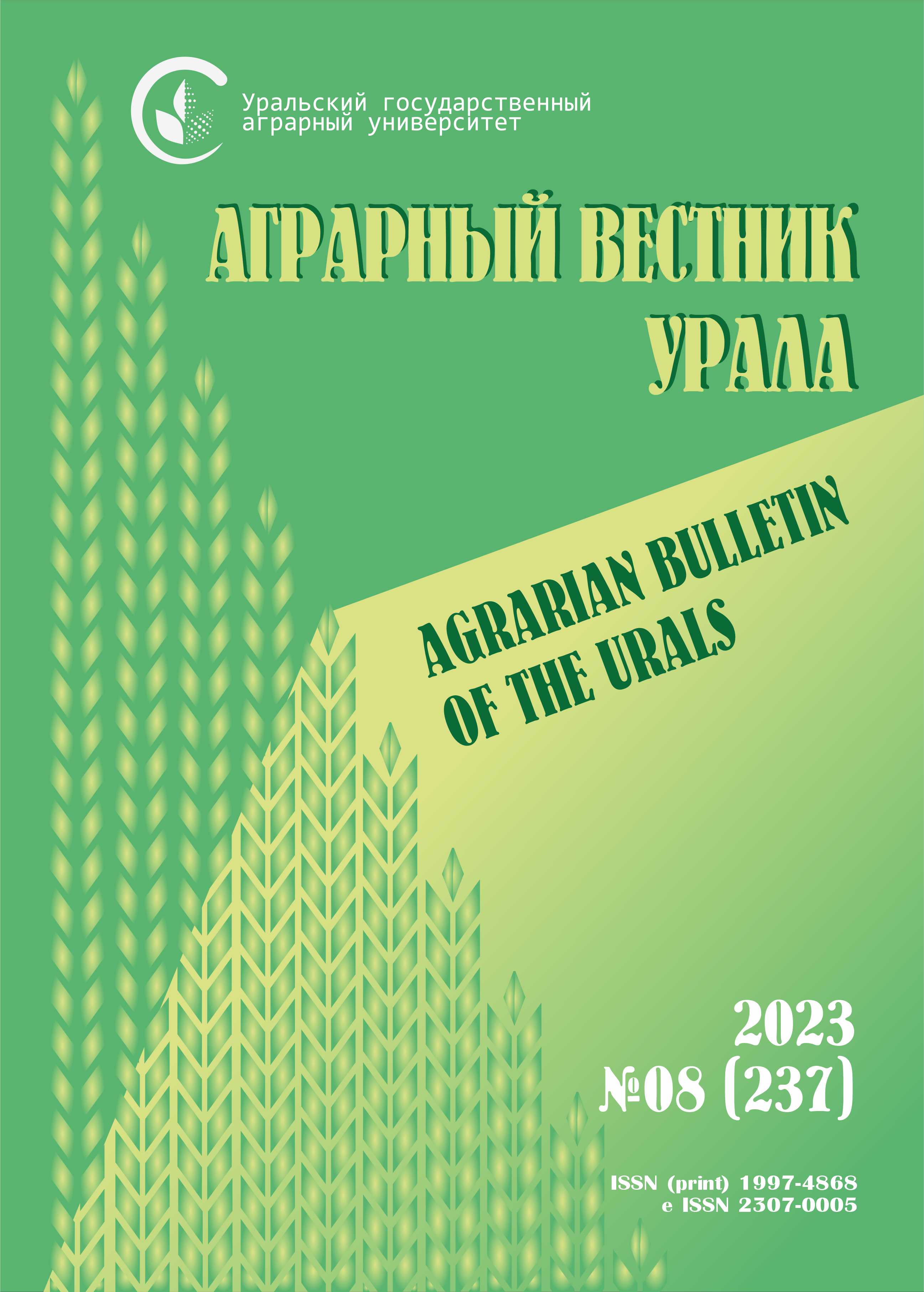Russian Federation
employee
Russian Federation
Abstract. The use of new drugs on highly productive animals is impossible without identifying the permissible consequences of the use of substances included in the composition on the functional state of individual organs, tissues and body systems. In this regard, the purpose of our study was to study the effect of the developed pharmaceutical compositions on the morphofunctional parameters of the organs of experimental animals. Methods. The study used 70 female non-linear white laboratory rats, which were given pharmaceutical compositions based on nizin in different doses for 30 days. During the study, biochemical and histological methods were used. Results. Significant statistical outliers have been established for a number of biochemical indicators that cannot fully indicate the presence or absence of a negative effect of the studied compositions on the functions of parenchymal organs of experimental animals, on the basis of which we conducted a histological study to detect morphological changes at the cellular level. In the experimental group of animals, where the dose of the developed compositions was 500 mg/kg, the structure of the organs corresponded to anatomical parameters, pathological processes were not detected. A study of the organs of animals receiving the developed compositions at a dose of 750 mg/kg revealed reversible compensatory changes in the liver and spleen. In the third experimental group, where the dose of the studied compositions was 1000 mg/kg, a number of pathological processes were registered, which were regarded as reversible pathological, however, the established changes characteristic of circulatory disorders in the vessels of the microcirculatory bed of the liver and kidneys were attributed to irreversible processes, as a result of which the dose is characterized as critical and is not recommended for use on highly productive animals. Scientific novelty. The morphological and functional state of organs of laboratory animals was studied for the first time when using new pharmaceutical compositions, which include nisin, silicon glycerolates and boron bisglycerolates.
biochemical markers, morphological structure, functional changes, experimental animals, laboratory rats, pharmaceutical compositions, nisin, silicon glycerolates, boron bisglycerolates
1. Zubareva V. D., Sokolova O. V., Bezborodova N. A., Shkuratova I. A., Krivonogova A. S., Bytov M. V. Molekulyarnye mehanizmy i geneticheskie determinanty ustoychivosti k antibakterial'nym preparatam u mikroorganizmov (obzor) // Sel'skohozyaystvennaya biologiya. 2022. T. 57. № 2. S. 237-256.
2. Sokolova O. V., Shkuratova I. A., Bezborodova N. A., Kozhuhovskaya V. V. Antibiotikorezistentnost' mikrobioty molochnoy zhelezy i reproduktivnogo trakta korov // Veterinariya. 2021. № 9. S. 10-15.
3. Krivonogova A. S., Sokolova O. V., Bezborodova N. A., Moiseeva K. V., Isaeva A. G. Dinamika antimikrobnoy rezistentnosti enterokokkov na molochno-tovarnoy ferme // Veterinariya Kubani. 2021. № 4. S. 9-12.
4. Ahmad-Mansour N., Loubet P., Pouget C., Dunyach-Remy C., Sotto A., Lavigne J. P., Molle V. Staphylococcus aureus Toxins: An Update on Their Pathogenic Properties and Potential Treatments // Toxins (Basel). 2021. No. 13 (10). Article number 677. DOI:https://doi.org/10.3390/toxins13100677.
5. Kawada-Matsuo M., Le M. N., Komatsuzawa H. Resistance in Staphylococcus aureus: Various Mechanisms and the Association with Pathogenicity // Genes (Basel). 2021. No. 12 (10). Article number 1527. DOI:https://doi.org/10.3390/genes12101527.
6. Amr E., Mohamed K. Bovine mastitis prevention and control in the post-antibiotic era // Tropical Animal Health and Production. 2021.Vol. 31. No. 53 (2). Article number: 236. DOI:https://doi.org/10.1007/s11250-021-02680-9.
7. Sharun K., Dhama K., Tiwari R., Gugjoo M. B., Iqbal Yatoo M., Patel S. K., Pathak M., Karthik K., Khurana S. K., Singh R., Puvvala B., Singh R., Singh K. P., Chaicumpa W. Advances in therapeutic and managemental approaches of bovine mastitis: a comprehensive review // Veterinary Quarterly. 2021. No. 41 (1). Rr. 107-136. DOI:https://doi.org/10.1080/01652176.2021.1882713.
8. Sokolova O. V., Bezborodova N. A., Bytov M. V., Zubareva V. D., Shkuratova I. A., Zaitseva O. S., Martynov N. A. Comparison of the microbiota of the reproductive tract and the mammary gland of cows with and without inflammation using 16S RRNA sequencing // International Transaction Journal of Engineering, Management and Applied Sciences and Technologies. 2022. Vol. 13. No. 6. Article number 13A6C. DOI:https://doi.org/10.14456/ITJEMAST.2022.108.
9. Lopes T. S., Fontoura P. S., Oliveira A., Rizzo F. A., Silveira S., Streck A. F. Use of plant extracts and essential oils in the control of bovine mastitis // Research in Veterinary Science. 2020. No. 131. Rr. 186-193. DOI:https://doi.org/10.1016/j.rvsc.2020.04.025.
10. Heilbronner S., Krismer B., Brötz-Oesterhelt H., Peschel A. The microbiome-shaping roles of bacteriocins // Nature Reviews Microbiology. 2021. No. 19 (11). Pp. 726-739. DOI:https://doi.org/10.1038/s41579-021-00569-w.
11. Vázquez R., García E., García P. Phage Lysins for Fighting Bacterial Respiratory Infections: A New Generation of Antimicrobials // Frontiers in Immunology. Microbial Immunology. 2018. Vol. 9. DOI:https://doi.org/10.3389/fimmu.2018.02252.
12. Khan F., Singh P., Joshi A. S., Tabassum N., Jeong G. J., Bamunuarachchi N. I., Mijakovic I., Kim Y. M. Multiple potential strategies for the application nisin and derivatives // Critical Reviews in Microbiology. 2022. DOI:https://doi.org/10.1080/1040841X.2022.2112650.
13. Arisov M. V., Urazaev D. N., Kachanova E. O., Pavlova A. S. General principles of conducting preclinical toxicology studies of antiparasitic drugs for veterinary use / IOP Conference Series Earth and Environmental Science. 2020. No. 548 (4). Article number 042042. DOI:https://doi.org/10.1088/1755-1315/548/4/042042.
14. Rukovodstvo po provedeniyu doklinicheskih issledovaniy lekarstvennyh sredstv / N. D. Bunyatyan, A. N. Vasil'ev, O. L. Verstakova, M. V. Zhuravleva, V. K. Lepahin, N. V. Korobov, V. A. Merkulov, S. N. Orehov, I. V. Sakaeva, D. B. Uteshev, A. N. Yavorskiy Moskva: Grif i K, 2012. 944 s.
15. Voytenko N. G., Makarova M. N., Zueva A. A. Variabel'nost' biohimicheskih pokazateley krovi i ustanovlenie referensnyh intervalov v doklinicheskih issledovaniyah. Soobschenie 1: krysy // Laboratornye zhivotnye dlya nauchnyh issledovaniy. 2020. № 1. S. 47-53. DOI:https://doi.org/10.29296/2618723X-2020-01-06.
16. Sorokina A. V., Alekseeva S. V., Eremina N. V., Durnev A. D. Opyt provedeniya kliniko-laboratornyh issledovaniy v doklinicheskoy ocenke bezopasnosti lekarstv (chast' 2: biohimicheskie i patomorfologicheskie issledovaniya) // Vedomosti Nauchnogo centra ekspertizy sredstv medicinskogo primeneniya 2019. T. 9. № 4. S. 272-279.









